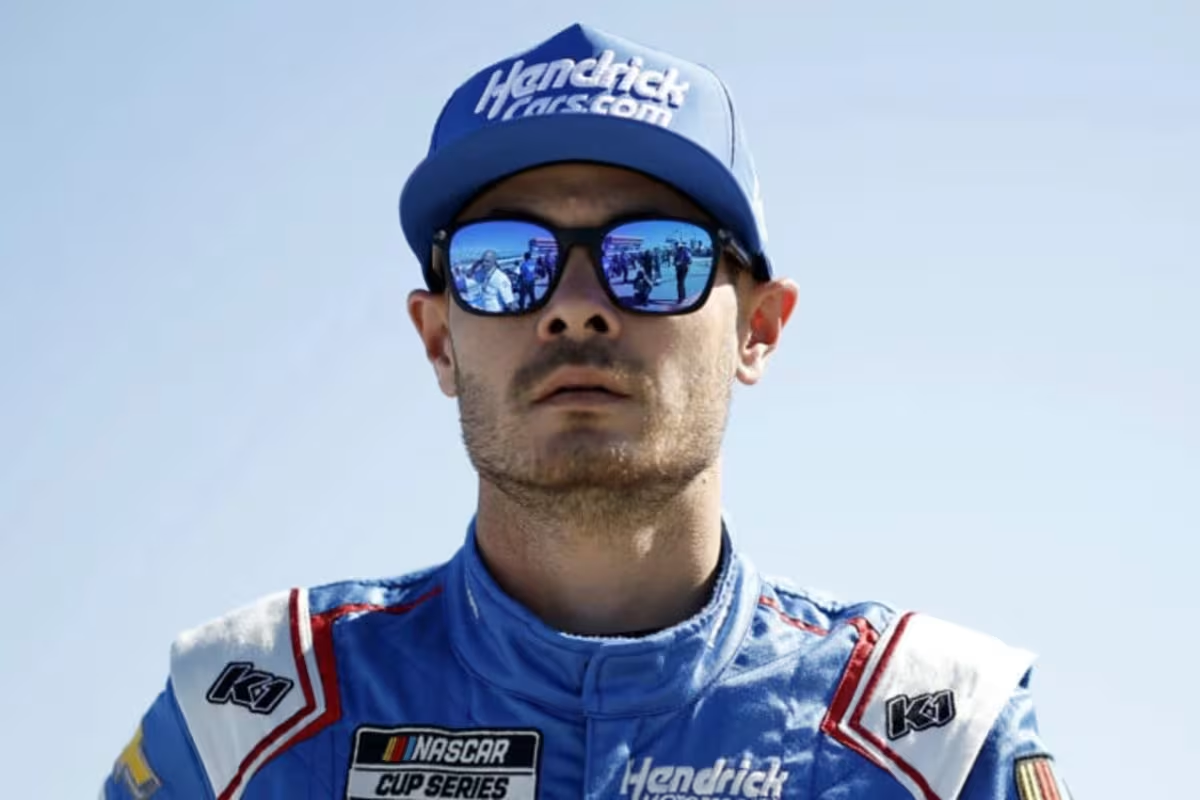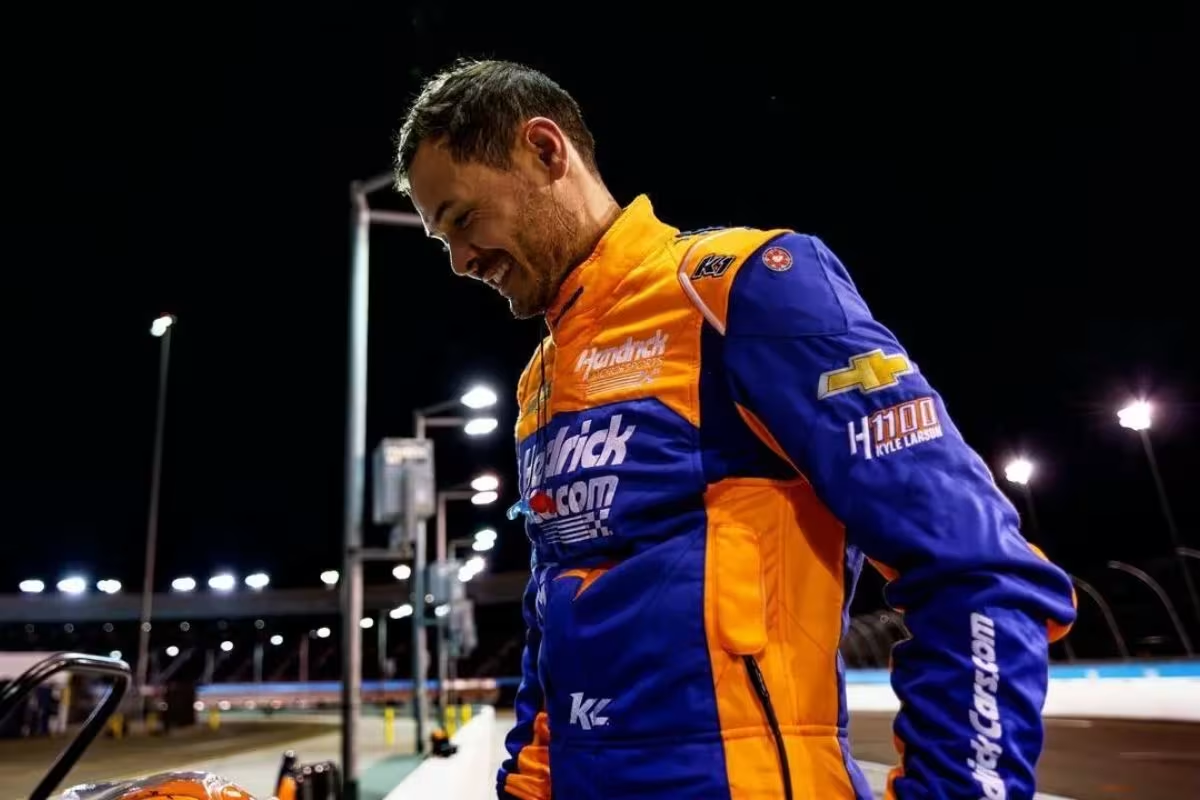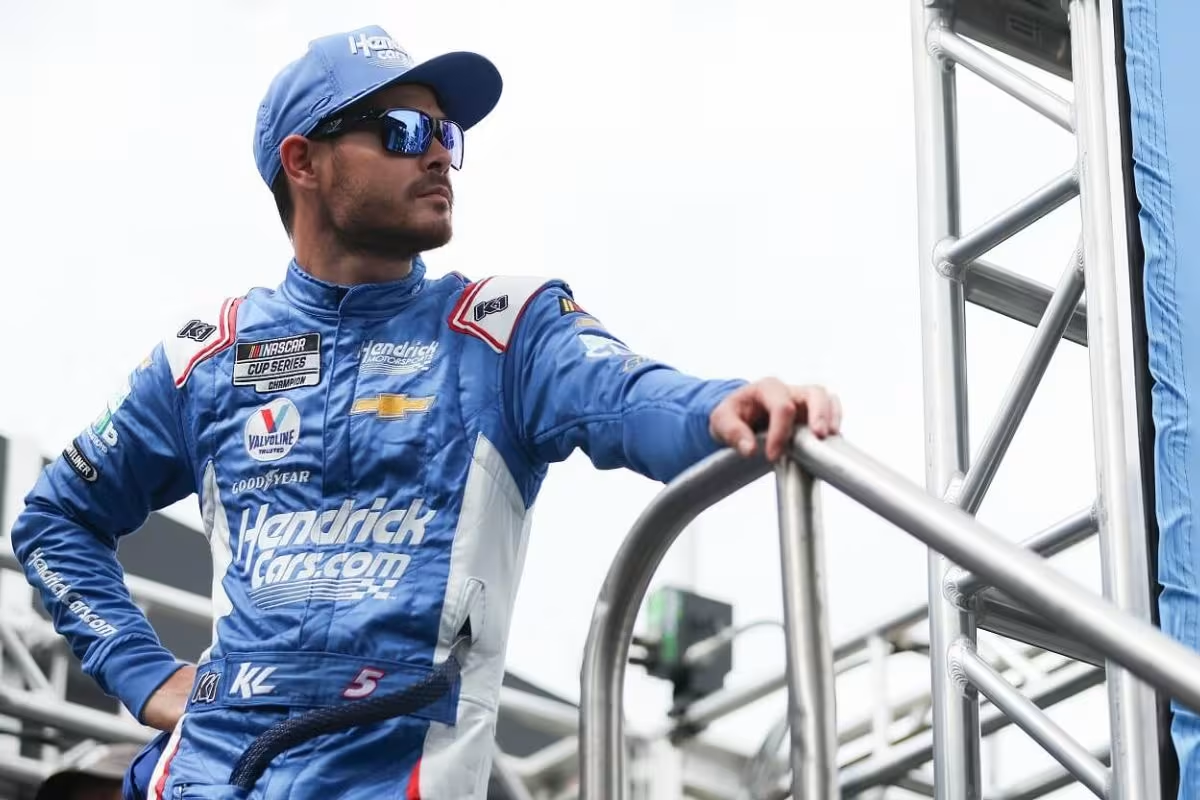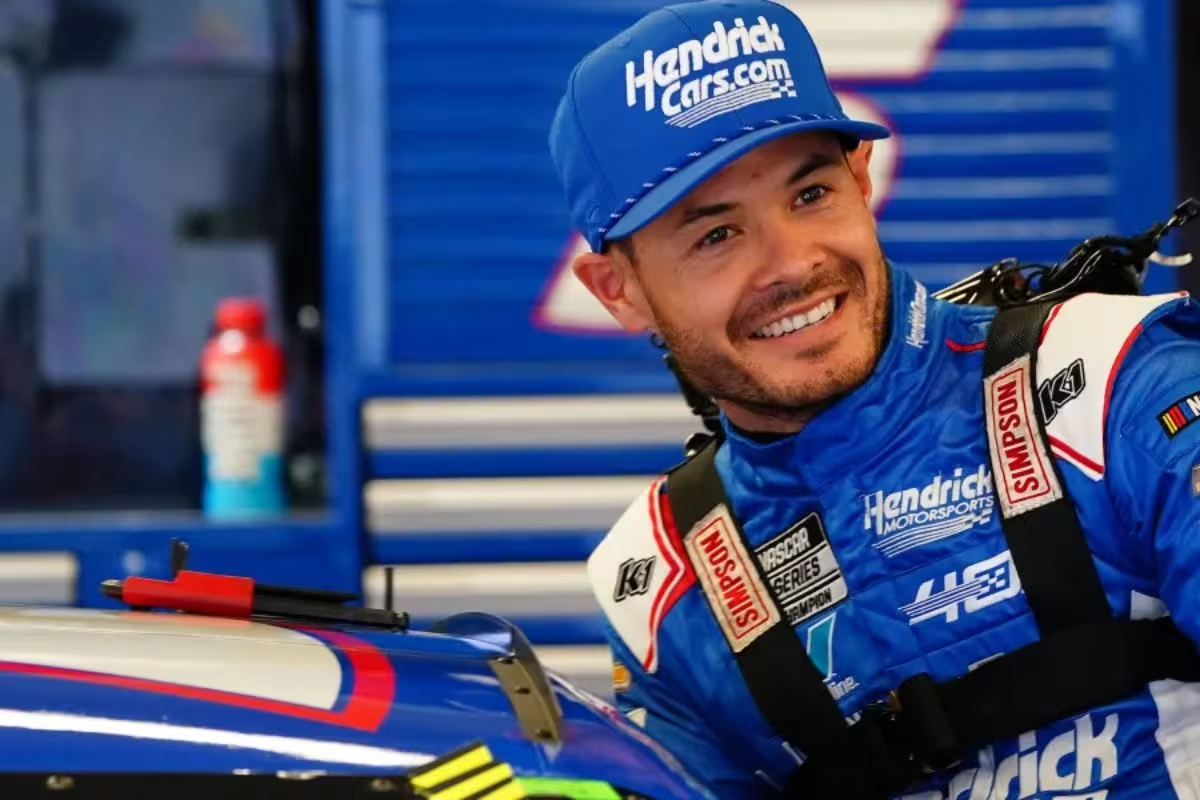Kyle Larson Hits Back at Critics: Kyle Larson‘s recent remarks regarding the criticism surrounding tire wear and race dynamics at Bristol reveal a nuanced perspective that challenges the common narrative among fans and analysts alike. By attributing the complexities of race outcomes to factors beyond just tire performance, Larson advocates for a more sophisticated understanding of the sport. His insistence on recalibrating expectations raises questions about the broader implications for fan engagement and race strategy. What underlying factors might be influencing this discourse, and how could Larson’s insights reshape future discussions about NASCAR’s evolving landscape?
Key Highlights
- Larson defends tire wear criticisms, stating that it’s often overstated and not solely due to Goodyear’s performance.
- He emphasizes the unique challenges of Bristol’s narrow track and limited overtaking opportunities affecting race dynamics.
- Larson calls for a shift in fan expectations, urging a better understanding of modern NASCAR realities and race setups.
- He points out that only one race in the past decade showed significant tire degradation, contradicting widespread frustration.
- Crew Chief Cliff Daniels supports Larson, advocating for skillful driving over chaos, highlighting the need for balance in racing excitement and integrity.
Kyle Larson Addresses Bristol Race Criticism
In the wake of the recent Bristol race, Kyle Larson has taken a proactive stance in addressing the criticism directed at NASCAR and Goodyear regarding the event’s lackluster performance. His decision to articulate a measured response on his official X account emphasizes a significant shift in the dialogue surrounding the sport.
Larson contends that the absence of tire wear during this race cannot be squarely attributed to Goodyear, particularly given that tire degradation had been a factor in their prior March event. This perspective challenges the notion of assigning blame without a thorough understanding of the complexities inherent to each race.
Larson’s commentary serves as a reminder that racing dynamics at Bristol are inherently challenging, characterized by a narrow track and limited overtaking opportunities. He encourages fans to recalibrate their expectations, recognizing that such conditions are endemic to the nature of the venue.
By advocating for a nuanced understanding of race performance, Larson positions himself as a voice of reason amidst the often emotional discourse surrounding racing outcomes. This call for patience and perspective is vital, especially in a sport where the stakes are high and emotions run deep.
The complexity of race strategy, tire performance, and driver skill cannot be simplified into binary judgments of blame. As Larson aptly highlights, the multifaceted nature of racing demands an appreciation for the unpredictable elements that define each event, reinforcing the idea that criticism should be rooted in informed analysis rather than reactionary sentiment.
Larson’s Insights on Tire Wear and Race Dynamics
Larson’s recent remarks provide a deeper understanding of the ongoing discussions surrounding tire wear and race dynamics at Bristol. In his interview with Dirty Mo Media, he expressed frustration with the frequent discourse on tire wear, suggesting that it has become an overemphasized issue in the context of racing at the famed track.
Larson pointed out that tire wear has historically been a challenge at Bristol, yet he highlighted a striking trend: in the last decade, only one race has truly showced considerable tire degradation. This observation raises critical questions about the changing nature of racing dynamics at Bristol.
“I think just kind of a- culmination of everybody, the fans, NASCAR, like I said. And some of the stuff like Nobody really has the answers, so it’s hard to… point fingers at people, but… It’s just kind of burns me out a little bit, talk about tire wear like it’s always been a thing at Bristol and it hasn’t. There’s only been one race where we’ve had tire wear in the last 10 or 11 years I’ve been going there.” – larson
Larson’s comments indicate a disconnect between fan expectations and the realities of modern NASCAR racing. The perception of tire wear as a pivotal factor in race strategy may not align with the data-driven outcomes observed in recent years. By asserting that race conditions have not revealed substantial tire wear, Larson invites a reevaluation of how teams approach race setups and strategies, particularly in a venue known for its unique challenges.
“We’re baffled, Yeah, we didn’t have tire work and I think we should have been more baffled. Why we did have tire wear randomly the one time. So, yeah, I mean, I think Bristol’s Bristol, it’s always… Fast pace. really hard to pass.” – Larson
Kyle Larson explains why he took to social media after seeing people complain about the Bristol Night Race. 📲 pic.twitter.com/Rf7F6ZEgMq
— Dirty Mo Media (@DirtyMoMedia) September 26, 2024
As fans and stakeholders continue to grapple with these dynamics, Larson’s insights serve as a catalyst for further dialogue on optimizing race performance while maneuvering the intricate interplay of tire wear, driver skill, and track conditions.
Fan Reactions and Criticisms Post-Race
Disappointment permeated the atmosphere following Kyle Larson’s commanding win at the Bristol playoff race, as fans and critics alike voiced their frustrations directed at Goodyear. The sentiment stemmed largely from the noticeable contrast between this race and the previous event at Bristol in March.
While the earlier race showcased 54 lead changes fueled by intense tire-wear conditions, this playoff encounter was marred by a lack of competitive dynamics, with Larson leading an overwhelming 462 of the 500 laps.
Critics argued that Goodyear’s tire compounds failed to foster the level of unpredictability vital for an exciting race. The tires, which lasted approximately 125 laps, did not degrade considerably, leading to a procession rather than a battle for position. Fans expressed their dissatisfaction on social media, contending that the monotonous nature of the event undermined the excitement typically associated with the playoffs.
Moreover, discussions among racing enthusiasts highlighted concerns regarding Goodyear’s ability to adapt to the evolving needs of the sport. Many voiced that the lack of tire wear not only diminished the tactical elements of pit stops but also resulted in an anticlimactic race finish.
This discontent echoes a broader concern within the NASCAR community about the direction of competition and the crucial role tire performance plays in race outcomes.
Crew Chief’s Perspective on Race Quality
The contrasting opinions surrounding the quality of the Bristol races highlight a substantial divide in perceptions among fans and team officials. While many spectators revel in the excitement generated by frequent lead changes and tactical adjustments, Kyle Larson’s crew chief Cliff Daniels, presents a more critical analysis. His perspective, articulated during an interview with SiriusXM NASCAR, highlights a fundamental concern regarding sustainability in race quality.
“The Bristol race, everyone wants to say was so amazing in the spring because of the tire coming apart. Well, no! It was the tire coming apart that created chaos. It wasn’t a good race. The chaos was fun for the moment but that’s not sustainable like that. That type of chaos is not what our sport needs on a weekly basis. We don’t, we don’t need chaos and calamity, you know, we need good, pure racing.” – Daniels
🗣️ "Now we have so much parity that we're trying to create disparity with the tires."@TeamHendrick Crew Chief @DanielsCliff weighs in on industry reaction from @ItsBristolBaby and how the "chaos" from the spring race should not be applauded.
More → https://t.co/MKhd9eLXG8 pic.twitter.com/9Jq1mXyGtZ
— SiriusXM NASCAR Radio (Ch. 90) (@SiriusXMNASCAR) September 26, 2024
Key points from Daniels’ commentary include:
- Chaos vs. Strategy: The tire wear-induced chaos may provide immediate thrills, but it undermines the essence of tactical racing.
- Long-term Implications: Daniels stresses that transient excitement is not a viable foundation for the sport’s future.
- Desire for Pure Racing: The crew chief advocates for races characterized by skillful driving and consistent performance rather than unpredictable calamity.
- Fan Engagement: While chaos may captivate audiences temporarily, it risks alienating those who appreciate technical proficiency.
- Balancing Act: The challenge lies in maintaining a balance between thrilling entertainment and the integrity of racing competition.
In contrast to the jubilant reactions from fans, Daniels’ critique calls for a re-evaluation of what constitutes an exemplary race. His insights illuminate the need for NASCAR to cultivate an environment where tactical depth and driver skill prevail over chaotic incidents.
News in Brief: Kyle Larson Hits Back at Critics
Kyle Larson’s commentary on the criticism surrounding tire wear and race dynamics at Bristol highlights the necessity for a nuanced understanding of racing complexities. By challenging fans to reconsider their expectations in view of the track’s unique characteristics, Larson advocates for a more informed discourse that transcends emotional reactions. This perspective not only emphasizes the multifaceted nature of motorsport but also encourages a deeper appreciation for the tactical elements that influence race outcomes.
ALSO READ: NASCAR Next-Gen Defense: Kyle Larson’s Crew Chief Urges Patience from Fans!




